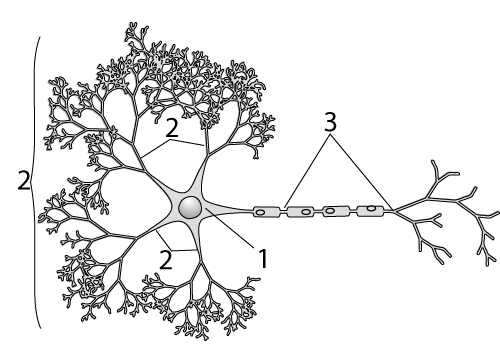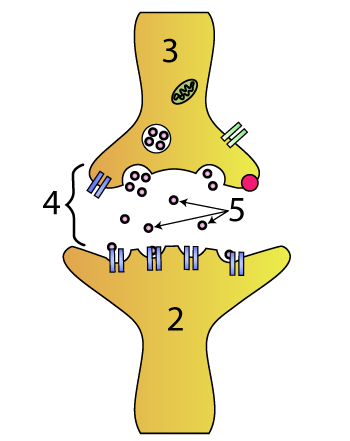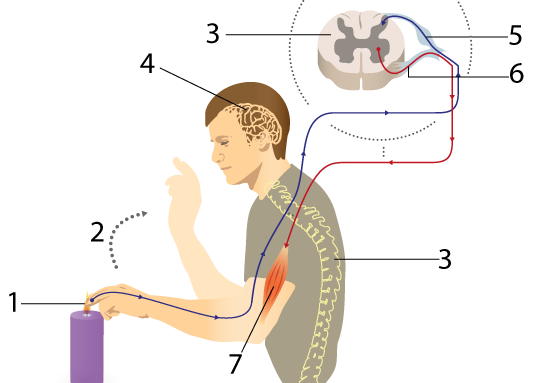Link to Nervous System Student Learning Guide
1. Introduction
The nervous system is what makes you the unique being that you are. It’s what enables you to learn, respond, feel, and remember. If you had a kidney or a heart transplant, then you’d still be you after the operation. But, in a science fiction brain transplant scenario, the result of a brain transplant would be the opposite: the brain becomes the owner of a new body.
In this course, our focus is going to be on more mundane matters, such as how your body (or the body of any animal, for that matter), can carry out a reflex, such as moving away from a harmful stimulus. As you’ll see, even the workings of what seems so simple can be beautifully complex.
2. What do you already know about reflexes?
[qwiz summary=”false”]
[h]Reflexes: What do you already know?
[q]
Imagine this. Accidentally, you touch something that’s burning hot. It could be a candle, or a hot frying pan. Almost instantly, a reflex moves your arm away from the source of the heat. Awareness of the pain and injury follows a moment later.
[q]Everyone has had an experience like this. It might not have involved a burn, but rather a sharp object that you stepped on. Or something like a ball that’s heading toward your eye, causing you to blink.
[q]
One thing we’re going to do in this series of tutorials is to explain how reflexes work. This will involve looking at how neurons (the specialized cells that make up your nervous system) receive, process, and send messages.
[q]A good way to mentally prepare yourself for learning is to access what you already know. Write down your response to the free response prompt below. Don’t worry if you can’t fully (or even partly) answer this question now: that’s the point of the work ahead. To stimulate your thinking, I’m including a diagram that shows some of the anatomy that underlies a reflex. The number 3 appears twice by design (it’s indicating both the vertebral column and the spinal cord that it encloses and protects).
Prompt: Discuss a) the biochemical and cellular mechanisms by which a sensory nerve cell transmits an impulse from your finger to your spinal cord, and b) how this message is transmitted to the motor nerve cell that controlled the reflex.
[x]After you’ve written your response, continue reading below to see how reflexes work.
[/qwiz]
3. The Nervous System: Some Basics
The nervous system is how animals get information from the environment, send signals around their bodies, and coordinate their responses to the environment.
Let’s start by labeling the diagram below. Don’t worry if you don’t know the answers. Making predictions (and getting feedback) enhances learning.
[qwiz qrecord_id=”sciencemusicvideosMeister1961-Nervous system functions, M28″]
[h]Major nervous system functions
[q labels = “top”]
[l]effector
[fx] No. Please try again.
[f*] Correct!
[l]central
[fx] No, that’s not correct. Please try again.
[f*] Correct!
[l]input
[fx] No, that’s not correct. Please try again.
[f*] Great!
[l]integration
[fx] No. Please try again.
[f*] Great!
[l]output
[fx] No, that’s not correct. Please try again.
[f*] Good!
[l]peripheral
[fx] No. Please try again.
[f*] Excellent!
[l]sensor
[fx] No. Please try again.
[f*] Great!
[q labels = “top”]
Let’s go over each term. For now, don’t worry about the details (like how neurons receive, integrate, and send messages). Just think of neurons as_________ that can transmit messages from one place to another.
- Sensors include _______, ears, nose, taste buds, and the various___________ for touch, heat, pressure, and so on on the skin.
- Sensors are parts of (or closely communicate with) _________ neurons. Sensory neurons are part of the___________ nervous system, and they send their________ to interneurons in the_________ nervous system (the brain and spinal cord).
- The function of interneurons is __________. In this context, integration involves taking in information from the outside world, and __________ what to do about it. Based on the the results of integration, interneurons will decide whether or not to send a signal to an ___________(muscles and glands). Those signals get sent to effectors through ___________ neurons, which are also part of the ____________ nervous system
- Note that in some of the simplest reflexes, there are no _____________. Instead, sensory neurons communicate directly with motor neurons, which send signals to ________s.
[l]central
[fx] No, that’s not correct. Please try again.
[f*] Correct!
[l]deciding
[fx] No. Please try again.
[f*] Great!
[l]effector
[fx] No, that’s not correct. Please try again.
[f*] Correct!
[l]eyes
[fx] No. Please try again.
[f*] Good!
[l]integration
[fx] No. Please try again.
[f*] Excellent!
[l]interneurons
[fx] No, that’s not correct. Please try again.
[f*] Correct!
[l]motor
[fx] No. Please try again.
[f*] Good!
[l]peripheral
[fx] No. Please try again.
[f*] Correct!
[l]receptors
[fx] No, that’s not correct. Please try again.
[f*] Correct!
[l]sensory
[fx] No, that’s not correct. Please try again.
[f*] Great!
[l]signals
[fx] No. Please try again.
[f*] Excellent!
[l]wires
[fx] No, that’s not correct. Please try again.
[f*] Good!
[q labels = “top”]And, just to be clear on the difference between the central and peripheral nervous system, label the diagram below.
[l]brain
[fx] No, that’s not correct. Please try again.
[f*] Great!
[l]central
[fx] No, that’s not correct. Please try again.
[f*] Excellent!
[l]peripheral
[fx] No. Please try again.
[f*] Excellent!
[l]spinal cord
[fx] No. Please try again.
[f*] Good!
[/qwiz]
4. Neurons, Synapses, and Reflex Arcs
The “wiring” of any nervous system function happens through neurons (nerve cells). Later in this module, we’ll study neurons in detail, but here’s what you need to know for now.

Information comes into a neuron at the dendrites (2), which can form a densely branched tree with hundreds or thousands of inputs. This information flows to the cell body (1). The cell body carries out most of the cell’s metabolic functions (such as protein synthesis and cellular respiration) and also integrates input from the dendrites. The result is a decision about whether the neuron should fire off a signal. That signal (the neuron’s output) gets sent through the neuron’s axon (shown at 3). The axon can communicate with an effector, or with another neuron.
A key thing to know about the nervous system is that with a few exceptions, neurons don’t touch their targets. Rather, there’s a tiny gap between one neuron and the next. That gap is called a synapse. It’s number 4 in the diagram on the left, and the entire structure on the right.
 |
 |
To cross the gap between the axon of the presynaptic (“before the synapse”) neuron and the dendrite of the postsynaptic (“after the synapse”) neuron, the presynaptic neuron releases a neurotransmitter (at 5, in the diagram to the right). The neurotransmitter diffuses across the synapse, where its message (a chemical version of “fire!” or “don’t fire”) gets interpreted by the postsynaptic neuron.
With that in mind, let’s look again at the reflex arc that we started this tutorial with.
 Number 1 is the stimulus (the injury-causing flame). The injury causes a signal to be sent along a sensory neuron (5) to the spinal cord (3), which is lodged within the vertebral column (also 3). In the spinal cord, the sensory neuron synapses with a motor neuron (6), which synapses with the effector (the biceps muscle, at 7), causing the response (2).
Number 1 is the stimulus (the injury-causing flame). The injury causes a signal to be sent along a sensory neuron (5) to the spinal cord (3), which is lodged within the vertebral column (also 3). In the spinal cord, the sensory neuron synapses with a motor neuron (6), which synapses with the effector (the biceps muscle, at 7), causing the response (2).
Note that the brain (4) is not involved. You don’t have to think to have a reflex. Usually you react first, and become aware of what happened later.
Here’s a more complex representation of another reflex arc: the patellar reflex (also known as a “knee jerk”).
 This reflex begins with a tap to the patellar tendon (1). The tap stretches the tendon and the quadriceps (the big muscle on the front of your thigh). The stretching is sensed by a sensor (2) at the end of a dendrite of a sensory neuron (3).
This reflex begins with a tap to the patellar tendon (1). The tap stretches the tendon and the quadriceps (the big muscle on the front of your thigh). The stretching is sensed by a sensor (2) at the end of a dendrite of a sensory neuron (3).
Neurons can be long, and this neuron goes all the way from your thigh to your spinal cord. In the spinal cord, the sensory neuron forms a synapse with a motor neuron (4). This motor neuron stretches all the way back to your quadriceps, where it synapses with that muscle at what’s called a neuromuscular junction (at 5).
For the quadriceps (your thigh muscle) to be able to contract and extend your leg, the opposing muscle, the hamstring, needs to be relaxed. This happens through the action of another branch of the sensory neuron that brought the impulse to your spinal cord (shown at 6). The axon of this sensory neuron forms a synapse with an interneuron in your spinal cord, which sends an inhibitory impulse to the neuron that connects with your hamstring (7). This inhibitory message to the hamstring says “don’t contract,” which allows the quadriceps to contract, causing the knee jerk reflex.
5. Reflexes: Checking Understanding
[qwiz random = “true” qrecord_id=”sciencemusicvideosMeister1961-Reflex Arcs, M28″]
[h]Reflexes: Checking Understanding
[i]
[q] Which number represents an effector?
[textentry single_char=”true”]
[c]ID c=[Qq]
[f]IE5pY2UhICYjODIyMDs3JiM4MjIxOyByZXByZXNlbnRzIHRoZSBlZmZlY3RvciAodGhlIG11c2NsZSB0aGF0IHJlc3BvbmRzIHRvIHRoZSBzdGltdWx1cyk=[Qq]
[c]IEVudGVyIHdvcmQ=[Qq]
[f]IE5vLg==[Qq]
[c]ICo=[Qq]
[f]Tm8uIEhlcmUmIzgyMTc7cyBhIGhpbnQuIFRoZSA=ZWZmZWN0b3I=IGlzIHRoZSB0aGluZyB0aGF0IGhhcyBhbiA=ZWZmZWN0LiBJbiB0aGlzIGNhc2UsIGl0JiM4MjE3O3MgdGhlIHBhcnQgd2hpY2gsIGFmdGVyIHJlY2VpdmluZyBhIHNpZ25hbCwgcmVtb3ZlcyB0aGUgaGFuZCBmcm9tIHRoZSBoYXJtZnVsIHN0aW11bHVzLg==[Qq]
[q] Which number or letter below represents the peripheral nervous system?
[textentry single_char=”true”]
[c]IE E=[Qq]
[f]IEV4Y2VsbGVudCEgJiM4MjIwO0EmIzgyMjE7IHJlcHJlc2VudHMgdGhlIHBlcmlwaGVyYWwgbmVydm91cyBzeXN0ZW0u[Qq]
[c]IEVudGVyIHdvcmQ=[Qq]
[f]IE5vLg==[Qq]
[c]ICo=[Qq]
[f]Tm8uIEhlcmUgYXJlIHR3byBoaW50cy4gMSkgJiM4MjIwO1BlcmlwaGVyYWwmIzgyMjE7IG1lYW5zICYjODIyMDt0b3dhcmQgdGhlIG91dHNpZGUuJiM4MjIxOyAyKSBUaGUgcGVyaXBoZXJhbCBuZXJ2b3VzIHN5c3RlbSBpbmNsdWRlcyB0aGUgc2Vuc29yeSBuZXVyb25zIHRoYXQgYnJpbmcgaW5wdXQgZnJvbSBzZW5zb3JzIHRvIHRoZSBjZW50cmFsIG5lcnZvdXMgc3lzdGVtLCBhbmQgbW90b3IgbmV1cm9ucyB0aGF0IHNlbmQgb3V0cHV0IHRvIGVmZmVjdG9ycy4=[Qq]
[q labels = “top”]Use the numbers above to organize the alphabetical list below into its correct sequence.
[l]1
[f*] Excellent!
[fx] No, that’s not correct. Please try again.
[l]2
[f*] Good!
[fx] No. Please try again.
[l]3
[f*] Excellent!
[fx] No, that’s not correct. Please try again.
[l]4
[f*] Correct!
[fx] No, that’s not correct. Please try again.
[l]5
[f*] Great!
[fx] No. Please try again.
[l]6
[f*] Good!
[fx] No, that’s not correct. Please try again.
[l]7
[f*] Great!
[fx] No, that’s not correct. Please try again.
[l]8
[f*] Correct!
[fx] No. Please try again.
[l]9
[f*] Good!
[fx] No. Please try again.
[l]10
[f*] Correct!
[fx] No, that’s not correct. Please try again.
[q] Which number refers to the axon of a presynaptic neuron?
[textentry single_char=”true”]
[c]ID M=[Qq]
[f]IEV4Y2VsbGVudCEgTnVtYmVyIDMgaXMgdGhlIGF4b24gb2YgYSBwcmVzeW5hcHRpYyBuZXVyb24u[Qq]
[c]IEVudGVyIHdvcmQ=[Qq]
[f]IE5vLCB0aGF0JiM4MjE3O3Mgbm90IGNvcnJlY3Qu[Qq]
[c]ICo=[Qq]
[f]IE5vLCBidXQgaGVyZSYjODIxNztzIGEgaGludDogJiM4MjIwOzImIzgyMjE7IGlzIGEgZGVuZHJpdGUgb2YgYSBwb3N0c3luYXB0aWMgbmV1cm9u[Qq]
[q] Which number refers to a synapse?
[textentry single_char=”true”]
[c]ID Q=[Qq]
[f]IFdheSB0byBnbyEgVGhlIHN5bmFwc2UsIGF0IDQsIGlzIHRoZSBnYXAgYmV0d2VlbiB0d28gbmV1cm9ucy4=[Qq]
[c]IEVudGVyIHdvcmQ=[Qq]
[f]IE5vLg==[Qq]
[c]ICo=[Qq]
[f]IE5vLCBidXQgaGVyZSYjODIxNztzIGEgaGludDogdGhlIHN5bmFwc2UgaXMgdGhlIGdhcCA=YmV0d2Vlbg==IHR3byBuZXVyb25zLg==[Qq]
[q] Which number refers to neurotransmitter?
[textentry single_char=”true”]
[c]ID U=[Qq]
[f]IFRlcnJpZmljISBUaGUgbmV1cm90cmFuc21pdHRlciwgYXQgNSwgaXMgdGhlIHNpZ25hbGluZyBtb2xlY3VsZSB0aGF0IGNyb3NzZXMgdGhlIHN5bmFwc2Uu[Qq]
[c]IEVudGVyIHdvcmQ=[Qq]
[f]IE5vLg==[Qq]
[c]ICo=[Qq]
[f]IE5vLCBidXQgaGVyZSYjODIxNztzIGEgaGludDogdGhlIG5ldXJvdHJhbnNtaXR0ZXIgaXMgYSBzaWduYWxpbmcgbW9sZWN1bGUgdGhhdCBjcm9zc2VzIHRoZSBzeW5hcHNlLg==[Qq]
[q] The dendrite of a postsynaptic neuron is indicated by
[textentry single_char=”true”]
[c]ID I=[Qq]
[f]IE5pY2UuIFRoZSBkZW5kcml0ZSBvZiBhIHBvc3RzeW5hcHRpYyBuZXVyb24gaXMgaW5kaWNhdGVkIGJ5ICYjODIyMDsyLiYjODIyMTs=[Qq]
[c]IEVudGVyIHdvcmQ=[Qq]
[f]IFNvcnJ5LCB0aGF0JiM4MjE3O3Mgbm90IGNvcnJlY3Qu[Qq]
[c]ICo=[Qq]
[f]IE5vLCBidXQgaGVyZSYjODIxNztzIGEgaGludDogTnVtYmVyIDMgaXMgdGhlIHRpcCBvZiBhIHByZXN5bmFwdGljIGF4b24u[Qq]
[q] Which number indicates a synapse?
[textentry single_char=”true”]
[c]ID Q=[Qq]
[f]IEdvb2Qgam9iISBUaGUgc3luYXBzZSwgYXQgJiM4MjIwOzQsJiM4MjIxOyBpcyB0aGUgZ2FwIGJldHdlZW4gdHdvIG5ldXJvbnMu[Qq]
[c]IEVudGVyIHdvcmQ=[Qq]
[f]IE5vLg==[Qq]
[c]ICo=[Qq]
[f]IE5vLCBidXQgaGVyZSYjODIxNztzIGEgaGludC4gSXQmIzgyMTc7cyB0aGUgZ2FwIGJldHdlZW4gdHdvIG5ldXJvbnMu[Qq]
[q] Which number is the cell body?
[textentry single_char=”true”]
[c]ID E=[Qq]
[f]IFdheSB0byBnbyEgVGhlIGNlbGwgYm9keSBpcyBhdCAmIzgyMjA7MS4mIzgyMjE7[Qq]
[c]IEVudGVyIHdvcmQ=[Qq]
[f]IFNvcnJ5LCB0aGF0JiM4MjE3O3Mgbm90IGNvcnJlY3Qu[Qq]
[c]ICo=[Qq]
[f]IE5vLCBidXQgaGVyZSYjODIxNztzIGEgaGludC4gQXMgaW4gYW55IGNlbGwsIHRoZSBjZWxsIGJvZHkgY29udGFpbnMgYSBudWNsZXVzLg==[Qq]
[q] An axon is at
[textentry single_char=”true”]
[c]ID M=[Qq]
[f]IEV4Y2VsbGVudC4gVGhlIGF4b24gaXMgYXQgJiM4MjIwOzMuJiM4MjIxOw==[Qq]
[c]IEVudGVyIHdvcmQ=[Qq]
[f]IE5vLCB0aGF0JiM4MjE3O3Mgbm90IGNvcnJlY3Qu[Qq]
[c]ICo=[Qq]
[f]IE5vLCBidXQgaGVyZSYjODIxNztzIGEgaGludC4gVGhlIGF4b24gaXMgdGhlIHBhcnQgb2YgYSBuZXVyb24gdGhhdCYjODIxNztzIG1vc3QgbGlrZSBhIHdpcmUu[Qq]
[q] Dendrites are indicated by which number?
[textentry single_char=”true”]
[c]ID I=[Qq]
[f]IEV4Y2VsbGVudCEgVGhlIGRlbmRyaXRlcyBhcmUgYXQgJiM4MjIwOzIuJiM4MjIxOw==[Qq]
[c]IEVudGVyIHdvcmQ=[Qq]
[f]IFNvcnJ5LCB0aGF0JiM4MjE3O3Mgbm90IGNvcnJlY3Qu[Qq]
[c]ICo=[Qq]
[f]IE5vLCBidXQgaGVyZSYjODIxNztzIGEgaGludC4gQXMgb3Bwb3NlZCB0byB0aGUgYXhvbiwgb2Ygd2hpY2ggdGhlcmUgaXMgb25seSBvbmUsIHRoZXJlIGFyZSA=bWFueQ==IGRlbmRyaXRlcy4=[Qq]
[q] Which number indicates the part that brings information into the cell?
[textentry single_char=”true”]
[c]ID I=[Qq]
[f]IE5pY2Ugam9iISBUaGUgZGVuZHJpdGVzLCBhdCAyLCBicmluZyBpbmZvcm1hdGlvbiBpbnRvIHRoZSBjZWxsLg==[Qq]
[c]IEVudGVyIHdvcmQ=[Qq]
[f]IFNvcnJ5LCB0aGF0JiM4MjE3O3Mgbm90IGNvcnJlY3Qu[Qq]
[c]ICo=[Qq]
[f]IE5vLCBidXQgaGVyZSYjODIxNztzIGEgaGludC4gWW91JiM4MjE3O3JlIGxvb2tpbmcgZm9yIHRoZSBkZW5kcml0ZXMu[Qq]
[q] Which number represents the part that sends information out of the cell?
[textentry single_char=”true”]
[c]ID M=[Qq]
[f]IEdvb2Qgd29yayEgVGhlIGF4b24sIGF0ICYjODIyMDszLCYjODIyMTsgc2VuZHMgaW5mb3JtYXRpb24gb3V0IG9mIHRoZSBjZWxsLg==[Qq]
[c]IEVudGVyIHdvcmQ=[Qq]
[f]IFNvcnJ5LCB0aGF0JiM4MjE3O3Mgbm90IGNvcnJlY3Qu[Qq]
[c]ICo=[Qq]
[f]IE5vLCBidXQgaGVyZSYjODIxNztzIGEgaGludC4gWW91JiM4MjE3O3JlIGxvb2tpbmcgZm9yIHRoZSBheG9uLg==[Qq]
[q] Which number represents the sensory neuron?
.
[textentry single_char=”true”]
[c]ID M=[Qq]
[f]IFdheSB0byBnby4gJiM4MjIwOzMmIzgyMjE7IGlzIGEgc2Vuc29yeSBuZXVyb24u[Qq]
[c]IEVudGVyIHdvcmQ=[Qq]
[f]IE5vLg==[Qq]
[c]ICo=[Qq]
[f]IE5vLCBidXQgaGVyZSYjODIxNztzIGEgaGludC4gU2Vuc29yeSBuZXVyb25zIGJyaW5nIGluZm9ybWF0aW9uIHRvIHRoZSBjZW50cmFsIG5lcnZvdXMgc3lzdGVtLg==[Qq]
[q] Which number represents a synapse with a motor neuron that sends a signal that causes the leg to extend.
[textentry single_char=”true”]
[c]ID Q=[Qq]
[f]IEdvb2Qgam9iISAmIzgyMjA7NCYjODIyMTsgcmVwcmVzZW50cyBhIHN5bmFwc2UgYmV0d2VlbiB0aGUgc2Vuc29yeSBuZXVyb24gKGF0IDMpIGFuZCBvbmUgb2YgdGhlIHR3byBtb3RvciBuZXVyb25zLg==[Qq]
[c]IEVudGVyIHdvcmQ=[Qq]
[f]IE5vLg==[Qq]
[c]ICo=[Qq]
[f]IE5vLCBidXQgaGVyZSYjODIxNztzIGEgaGludC4gTG9vayBmb3IgYW4gYXJyb3cgdGhhdCBpbmRpY2F0ZXMgb3V0cHV0Lg==[Qq]
[q] Which number represents a synapse between a nerve and a muscle (also known as a neuromuscular junction).
[textentry single_char=”true”]
[c]ID U=[Qq]
[f]IEV4Y2VsbGVudCEgJiM4MjIwOzUmIzgyMjE7IHJlcHJlc2VudHMgYSBzeW5hcHNlIGJldHdlZW4gdGhlIG1vdG9yIG5ldXJvbiBhbmQgdGhlIHF1YWRyaWNlcHMgbXVzY2xlICh0aGUgZWZmZWN0b3IpLg==[Qq]
[c]IEVudGVyIHdvcmQ=[Qq]
[f]IE5vLg==[Qq]
[c]ICo=[Qq]
[f]IE5vLiBMb29rIGZvciBhIGNvbm5lY3Rpb24gYmV0d2VlbiBhIG5lcnZlIGFuZCBhIG11c2NsZS4=[Qq]
[q] Which number represents a synapse between a sensory neuron and an interneuron?
[textentry single_char=”true”]
[c]ID Y=[Qq]
[f]IEZhYnVsb3VzISAmIzgyMjA7NiYjODIyMTsgcmVwcmVzZW50cyBhIHN5bmFwc2UgYmV0d2VlbiB0aGUgc2Vuc29yeSBuZXVyb24gYW5kIHRoZSBpbnRlcm5ldXJvbi4=[Qq]
[c]IEVudGVyIHdvcmQ=[Qq]
[f]IE5vLg==[Qq]
[c]ICo=[Qq]
[f]IE5vLiBMb29rIGZvciBuZXVyb24gbG9jYXRlZCBpbiBiZXR3ZWVuIGEgc2Vuc29yeSBuZXVyb24gYW5kIGEgbW90b3IgbmV1cm9uLg==[Qq]
[x][restart]
[/qwiz]
Links
- How Neurons Conduct Nerve Impulses (the next tutorial in this series)
- Nervous System (Module 28) Main Menu
